As I write – October 2015 – I’m working on the forthcoming annual Crop Circle Year Book for 2015. As part of putting the book together I’m now revisiting many of the formations from this season and starting to look at them in detail. Of course the size and scope of the year books give room for only the most concise analysis and discussion – but in the coming months I hope to share some of the things I have looked at for inclusion in the book in a series of blogs.
The Haselor Star 19th July 2015
Haselor, is located very near to the town of Alcester in Warwickshire (not too far from Stratford-Upon-Avon) and in recent years particularly, the county of Warwickshire has seen a collection of very fine crop circles within its borders. Alcester is identified as an old Roman settlement.
At first glance the crop circle at Haselor was undoubtedly a design based around the number eight, with its eight-pointed star being the main feature. The formation is made from a series of concentric circles and offset circles which create a crescent in the middle part of the design – 5 circles in all. In the offset centre circle sits the very fine eight-pointed star, the points are standing and as they approach the centre circle the arms cross over and under one another in Celtic Knot-like fashion. From five of the points of the star, emanate straight lines that reach out through the crescent, to the outer band of standing crop. Where the offset circle touches the outer band at the bottom of the design there is no room for the three remaining points to have lines. So the numbers five and eight are picked out for special attention. Five and eight are of course two sequential Fibonacci numbers and along with thirteen, they are the three most common Fibonacci numbers found in nature on planet Earth.
When I sat down to draw the crop circle I assumed the central star would be one of the two classical eight pointed stars. We’ll call them type A and type B. Both stars can be created by first drawing a circle and dividing the perimeter into eight equal sections at: 0/360, 45, 90, 135, 180, 225, 270 and 315 degrees.
The type A star is created by drawing a line between each third point, this creates a star made from two squares – the angle of the points of the star are 90 degrees. The type B star is created by joining each fourth point; this creates a star with much narrower points and angles of 45 degrees (see Fig 1.). Remember this idea of the angle of the points, we’ll come back to it later.
Looking at the photograph, it was very clear this star was not the double-square type A , and so because I did not follow the first rule of drawing crop circles – “before putting pencil to paper look at the photo until your head bleeds” – I immediately drew in a type B eight-pointed star. As soon as I had done it and looked it I knew it was completely wrong. Instantly, this indicated that something different and interesting was going on in the geometry of this formation.
It is at times like these that drawing on top of a photo becomes an invaluable exercise. Where necessary the picture may need to be manipulated to become as near an overhead image as possible, but having done this you can print out the image and draw over the photo. As soon as I did this, I began to see the unusual, but interesting way this star had been put together.
This was an eightfold star created around a central circle, rather than within a containing circle – as I described above in the construction methods for the Type A and B eight-fold stars. If one may consider for the moment that each point of a star is a triangle without a bottom, two lines coming together to create a point, then in order to create this star two lines are placed at 180 degrees to one another on the perimeter of the circle, then come together to create a point. This is repeated around the circle. As soon as I could see this, the drawing fell into place. When the star is drawn without the centre filled in (see Fig 2.) you can see that some of the lines are concave, unlike the classical Type A and B stars, in which all the lines are straight. This is not the first time the circle-makers have used non-classical constructions of shapes. At Gussage St. Andrew in 2014 a hexagram (six-pointed star) was constructed around a central hexagram, rendering similarly bent lines.
According to geometer Michael Schneider, eight is the number of Periodic Renewal. This is most easily demonstrated by its role in the musical scale. When the seven notes of the classical scale are played alone they sound incomplete; it creates a strange anti climax. It is not until the OCTave is played that the scale becomes a whole and feels complete. The octave simultaneously takes us back to the beginning and also on to the next level – or scale. Unlike its younger sister, the virginal seven, eight mixes incredibly well with other numbers and is often described as the most promiscuous number in the classical decad (numbers 1-10). It is the numerical root of the i-ching, it is also widely used in sacred Islamic patterning, and in Alchemy it is the number of the elements and their corresponding qualities – Earth, Air, Fire and Water – Dry, Wet, Cold and Hot. Aristotle drew a double square, type A star to illustrate the elements and their properties in just this way.
The number eight might therefore be said to represent that almost indefinable transformation from one level to the next, a transformation that moves us towards a new wholeness, in which we might be said to be different and yet still remain the same. All experience changes us in some way, yet we still at our core remain the same; we are changed, but yet are still ourselves. This kind of experience is much talked about psychological therapies, where patients are said to move towards wholeness, who are always changed by their experiences, but of course, at heart remain the same person. It is a fascinating subject for contemplation, an archetypal human process. In specific relation to the crop circles, eight may symbolise the transformative effect of coming face to face with “the other” and its transformative effect upon the psyche. We are the same person we always were, but somehow the circles have that ineffable ability to subtly change us and move us towards the next level of wholeness.
Finally, I arrive back at Fibonacci and five, eight and thirteen. In addition to the eight above, five is the number of life, and generation. It speaks of living processes and of growth patterns. Five of course, or more accurately the pentagram, generates the proportion the Golden Section (phi), which is related to the Fibonacci sequence by the fact that if you divide any number in the sequence into its predecessor it generates an excellent approximation of Phi – the higher the numbers the more accurate the approximation. In marrying five and eight we might talk of a process of change, which is a living process, one which generates movement towards new levels of being, while keeping the whole intact. The Golden Section is often called the breath of God, as it is found in the proportions and growth processes of all living things, its easy to see it like the waves of breath on water. It speaks directly of the Divine Spirit manifesting through, or animating the substance of the world. Anyone who has yet to experience the profundity of number is, I fancy, approaching it right now!
So where is thirteen you may well ask – that other number of transformation? Well, remember I asked you to remember the angles of the points of the stars? That our type A double-square has angles of 90 degrees and our type B has angles of 45 degrees? Well the star at Haselor had angles in its points of 32 degrees. Thirty-two multiplied by eight is 256. 2 + 5 + 6 = 13
On a very personal level this formation spoke to me about something I have been long grappling with and that is that potential for personal transformation that the crop circles bring. People talk about messages, codes, information, languages, but to me the crop circles have always seemed (apart from a few well-known instances) beyond those very ‘human’ concepts. They speak directly to the heart, spirit or soul, often bypassing the intellect entirely. In our rational/mental age we look for the rational, intellectual, the logical. But I think in the crop circles we have something that calls us beyond that, something that calls for us to develop an intelligence of the heart or soul. My overwhelming sense is of something that is timeless, non-linear and that has no one single interpretation.
I loved this formation, I loved drawing it, I loved contemplating its numbers and their qualities; I valued the experience of letting the design inside and listening to what it evoked within me. So little in life allows for such exploration. The crop circles are truly a remarkable gift.
Karen Alexander
With thanks to Steve Alexander, Kayleigh Douglas-Alexander & Michael Glickman


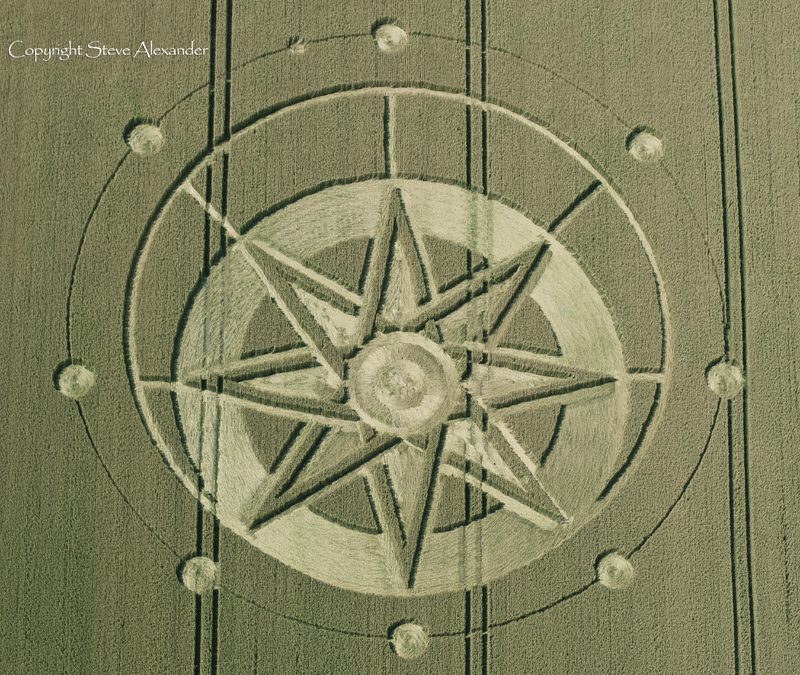
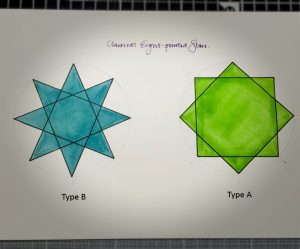

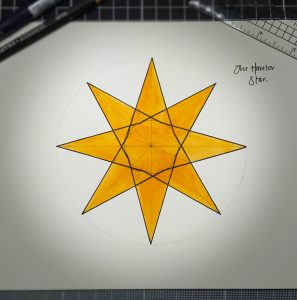

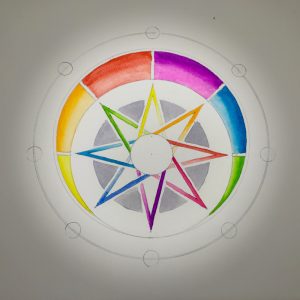
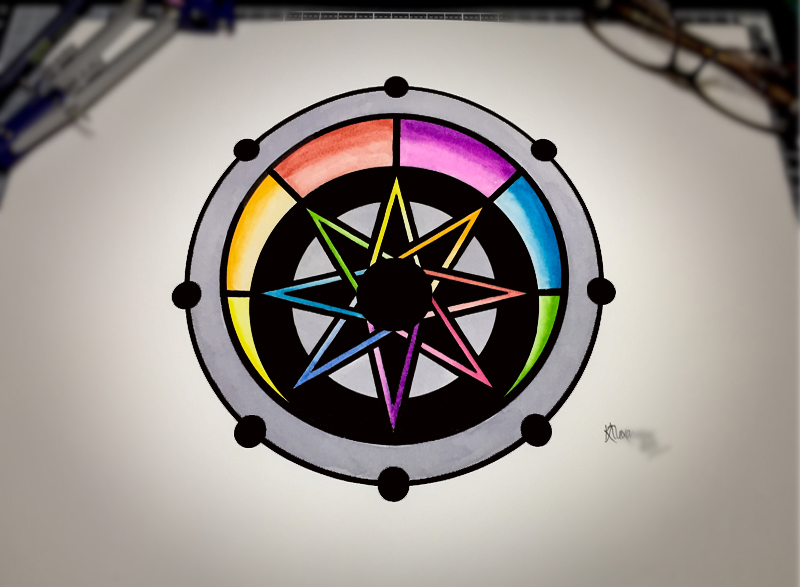
Dear Karen –
Thanks for living your highest joy and expressing your thought processes as you do so. I am starting to draw the crop circles now also, at my kitchen table here in North Carolina.
I also have plans to create art pieces from them using various materials. My first idea is to screw galvanized sheet metal to wood, using the Tidcombe formation of 2007, the picture on this month’s calendar. As I stared at the photograph on Friday morning, it seemed to have a medieval look to it, and I imagined the tiny circles as rivets attaching wrought iron to a wooden door. I found the perfect size of sheet metal in the scrap pile at work later that day.
Speaking of tiny circles, I was wondering if you eventually added the tiny little circle to the left of the top circle to your Haselor star drawing? If not, why not?
Here is a synchronicity for you: When I told my friend Tony my idea yesterday, he noticed that the photograph was not taken from directly overhead, and offered to correct the distortion in his computer so I can print it out as a template. I protested that this was not necessary as I would just recreate the pattern geometrically. Before I started on the project this morning, I happened to read this blog (for the first time), suggesting the same method he did! So of course I will now take him up on his offer.
I want to take this opportunity in communication to note an earlier observation I had, that the traditional method of drawing black and colors on a white background is opposite of the visual appearance of the crop formations. So I am using white and colored pencils on black paper. This will allow me to draw the often ornate lay of the crop, which I notice is not possible with the traditional approach.
Lovingly,
David
Hi David, many thanks for your thoughtful response. I had totally forgotten the little satellite circle on the outer ring, so will now add that in and look at angles etc. I’d love to see any drawings or artworks you create using the circles as a base. I’m thinking we should have a crop circles art page somewhere because there are a lot of artists who do wonderful work with the circles. I like the idea of working on black paper to be able to draw the lay of he crop, I recently bought a couple of prints from a Finish artist who works in pastels on dark papers and they were beautiful.
A crop circle art page sounds great! Maybe it could somehow be included as a part of the archive, associated with the particular crop circle that inspired it, or at least in the same archive year. 🙂
The Haselor circle ignores the tiny circle just to the left of the top circle shown in the original photo. In line with my interpretive system for crop circles, here is my interpretation:
Eight comets will be traveling around the Sun, except for one, the Sun Comet, destined to strike the Sun. The Warning Comet is shown on top with its one major fragment. The Sun itself is the thick ring, in front of which is an octagram representing the tails of all eight comets, and a conglomerate black circle in the center representing all the eight impacts, implying all eight are coordinated to accomplish the common purpose. The Sun is off-center, perhaps to suggest the different distances each comet will experience as they travel around the Sun. Likewise, the lines for 5 of the 8 may indicate relative angles of their trajectories as they approach the Sun. The actual angles are not given. The trajectory angle for the Warning Comet wasn’t revealed before this crop circle.
Fairly! This was a truly excellent post. Thank you for your supplied advice